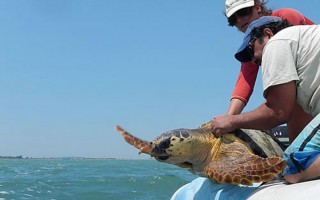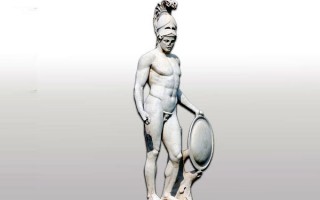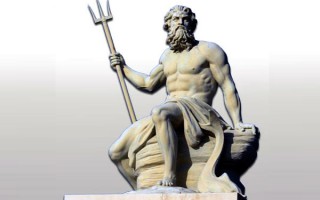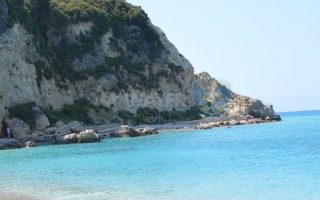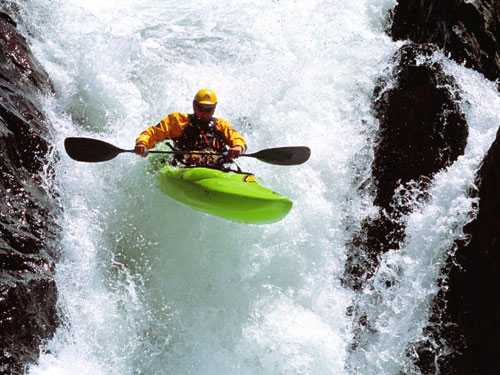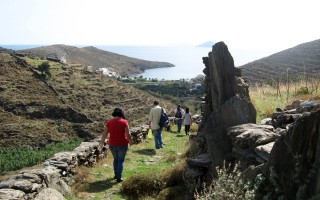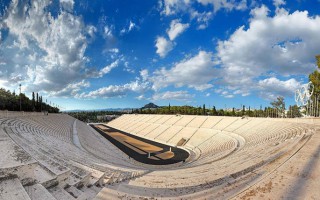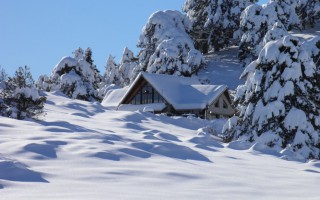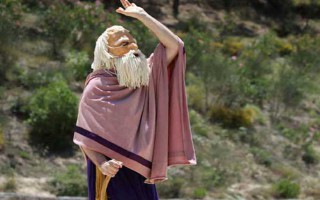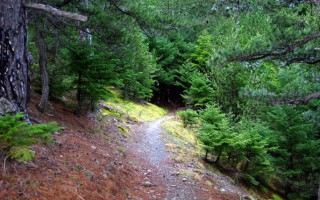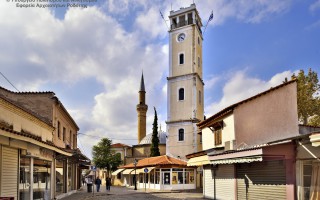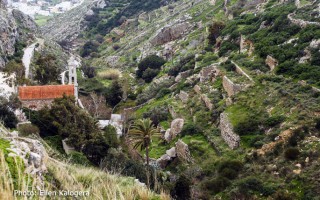 The picturesque town of Hydra, the capital and port of the island, has been declared a “preserved historical site.” Located in the center of the island, its magnificent mansions and simple, stone-built houses overlook the entrance of the famous port. During the War of Independence in 1821, Ibrahim Pasha called the island “Little England,” due to the huge fleet of 186 ships moored in the harbour, their well-trained crews ready for battle. And the island produced its own share of heroic sailors and sea captains, warriors like Miaoulis, Tobazis and Sachtouris.
The picturesque town of Hydra, the capital and port of the island, has been declared a “preserved historical site.” Located in the center of the island, its magnificent mansions and simple, stone-built houses overlook the entrance of the famous port. During the War of Independence in 1821, Ibrahim Pasha called the island “Little England,” due to the huge fleet of 186 ships moored in the harbour, their well-trained crews ready for battle. And the island produced its own share of heroic sailors and sea captains, warriors like Miaoulis, Tobazis and Sachtouris.
 Since the 1950s, Hydra has been the favorite destination of the international jet-set. Picasso and Sagal walked these narrow streets, and Sofia Loren swam in these waters. Hydra’s numerous tavernas have served the famous, and infamous alike, from personalities of international politics to business tycoons.
Since the 1950s, Hydra has been the favorite destination of the international jet-set. Picasso and Sagal walked these narrow streets, and Sofia Loren swam in these waters. Hydra’s numerous tavernas have served the famous, and infamous alike, from personalities of international politics to business tycoons.
Cars are not allowed on Hydra. All transportation is performed either on foot, or atop the traditional mode of transport here: The ubiquitous little donkeys, who are considered to be a very special species, since they are familiar and comfortable with climbing up and down the hundreds of steps around the island’s streets. Numerous cultural events are held in Hydra each year, including the Annual International Convention for Rebetiko.
Source: www.athensattica.gr
Zakynthos island is situated in the Ionian Sea off the west coast of mainland Greece. The climate is warm with plenty of sunshine. The island has an area of 406,000 ha and its coastline is approximately 110km long. However, only a small part of the coast is sandy beach. In Zakynthos, loggerhead sea turtles nest mainly on the beaches within the Bay of Laganas, which is on the southern part of the island. ARCHELON’s systematic surveys have confirmed that the Bay of Laganas is the most important nesting area for the loggerhead sea turtle (Caretta caretta) in the Mediterranean Sea. This led to the establishment of the National Marine Park of Zakynthos in 1999.
Historical background to the legal protection of the nesting beaches of Zakynthos and the marine zone of the Bay of Laganas.
Due to the importance of Zakynthos as a reproduction area for the loggerhead sea turtle in the Mediterranean, the state introduced measures for its protection since 1984. The purpose of the legislation was to control and regulate development while maintaining the quality of the nesting beaches so that the sea turtles can continue visiting Zakynthos for generations to come. The 1984 measures were further strengthened in 1990 with the signing of a Presidential Decree. Based on this legislation, in addition to specific limitations relative to visitor numbers and the use of sunbeds and umbrellas, the following are mentioned:
- Tourist developments are not permitted behind nesting beaches and the building of residences is strictly regulated
- Artificial lighting is not permitted to affect nesting beaches
- Vehicle use is not allowed on the beach
In 1988, by Ministerial Rule two marine zones were established. These occupy a large proportion of Laganas Bay. Within zone A, no boats or fishing activity are allowed. Accordingly, in zone B the speed limit is 6 knots, while anchoring is not allowed. Fish farms are prohibited in both zones. In 1994, after sustained effort by ARCHELON and other environmental organizations a third zone was established, zone C, in which anchoring is allowed but the speed limit of 6 knots applies. Consequently, speed boats were almost completely prohibited from the Bay of Laganas. These marine zones are marked with buoys in order to be visible to boat users.
Zakynthos has the privilege to host a very large number of sea turtles in the Bay of Laganas every summer. They migrate thousands of kilometres to reproduce within the bay. Turtle spotting by beach visitors and tour boats is a compatible ecotourism activity with positive prospectives, as it empowers public awareness about sea turtles and therefore their protection, as long as this experience takes place under certain conditions that primarily respect the sea turtles.
On every encounter with a sea turtle in the water, it is very important to seek the least possible disturbance of the animal (as in every other wildlife encounter). This can be achieved when turtle spotting fulfils at least some basic standards that guarantee the calmness of the sea turtle, such as:
- doesn’t exceed 10-15 minutes near the same turtle,
- holds a distance of 10-15 metres from the animal,
- avoids crowding near it (by beach users or boats, with no more than two boats at any one time) and the observers remain calm (e.g. Low-voiced conversation),
- observations are made at a low speed in order not to disturb the animal (no more than two knots),
- any physical contact with the animal is avoided,
- the animal is not approached from the front (and the boat does not pass over it)
- the observers move away on the first indication that the animal is disturbed (e.g. Sudden change of direction, acceleration, sudden diving while basking, often emergences to breathe)
- observations are made during the day (and not during the night).
However, sea turtle observation activities carried out in the Bay of Laganas do not always follow the above basic rules of sustainable observation, nor do they follow the regulations for this special area (e.g. the speed limit of 6 knots to avoid collision with a sea turtle), often placing the turtles in danger.
All visitors of the National Marine Park of Zakynthos should be fully informed about the existing regulations to ensure the well-being of this important sea turtle population concentrated in the Bay of Laganas. Because these regulations have been set to ensure the coexistence of humans and sea turtles to the benefit of both.
Source: www.archelon.gr
διαβάστε περισσότεραAfter preliminary surveys carried out in 1989, ARCHELON identified a significant number of loggerhead sea turtle (Caretta caretta) nests along some of Crete’s beaches. Since then, projects for the monitoring of the reproductive activity, protection of nests, and public awareness take place at three of the most important nesting areas on the island, and in particular in Rethymno and the bay of Chania along the north coastline, and in the bay of Messara on the south. In recent years, about 21km of beach (12km in the area of Rethymno, 5km in the bay of Chania, and 4km in the bay of Messara) are monitored every summer.
Human impacts
The nesting beaches of Crete are subjected to strong pressure, primarily due to their increased use for tourism and recreation. Beach umbrellas, sunbeds, artificial lights, and vehicle use on the beach are only some of the problems that sea turtles face.
Nest Management
Due to the human impacts and natural threats, various protection measures are implemented on all nests found within the nesting areas of Crete.
All nests found during the morning surveys on the beach are checked for the suitability of their location. If they are not believed to be threatened by innundation or damage due to human activities (e.g. close to umbrellas or sunbeds) they are left where they are and a metal cage is placed above them. The cages identify the location of each nest and protect them from accidental damage by beach users. The sign they carry (in three languages: Greek, English, and German) informs the public about the purpose of the cages.
If a nest location is believed to be unsuitable, the nest is relocated to a safer part of the beach or within a natural hatchery. Hatcheries are fenced beach plots with an expected high hatching success. These are also used as a public awareness tool, since they attract the attention of beach users.
During the hatching period, the increased number of sources of artificial light on the back of the beach disorients hatchlings. They are attracted by the lights and head towards the land instead of the sea. Efforts to gradually mitigate the problem of light pollution include communication with local authorities and local business operators in order to persuade them to switch off the lights that cause disorientation. If this is not possible and the effort is unsuccessful, ARCHELON places light fences around the nests to prevent the hatchlings from disorienting. The fences, with a height of around 20cm, are made of wooden or paper boards and are inserted vertically into the sand along both sides and the back of the nest, thus creating a “path” towards the sea. This intervention significantly reduces the mortality of hatchlings caused by light pollution.
Local community cooperation
A management plan exclusively regarding the nesting beaches of Crete was formulated by ARCHELON in 1997. It suggests practical solutions for the conservation of the coastal zone and the sea turtles. The management plan was designed to be applied at a low cost while attempting to integrate sea turtle conservation and the sustainable development of the local tourism industry. Protected zones within development areas, such as Crete, can only be sustained when the local communities incorporate them to their development plans. Consequently, ARCHELON is in close cooperation with all involved local authorities and the tourism industry at a local and national level for the implementation of the management plan.
Regular communication and relations with all involved local authorities are crucial. ARCHELON is informed by the local authorities and operates as an advisor on activities that may have an impact on the nesting beaches or the sea turtles (e.g. the use of heavy machinery for cleaning beach sand).
In addition, ARCHELON promotes the incorporation of sea turtles in Crete’s tourism product by demonstrating mutual benefits. Turtles are an indication of a healthy natural environment that can be promoted at a local and international level. ARCHELON’s attempts to combat important problems the sea turtles face, such as pollution and coastal degradation, contribute towards sustaining a high quality level of tourism.
Tourist agencies prove to be an important ally for ARCHELON, since they have the ability to provide information to their customers prior to and upon arrival to the nesting areas. ARCHELON cooperates with an increasing number of tourist agencies, such as TUI, TUI Nordic, HOTELPLAN, and PURE CRETE.
Additional long-term cooperation with hotel chains such as GRECOTEL and GERANIOTIS HOTEL is crucial. ARCHELON is an advisor to the Environmental Department of GRECOTEL in issues such as coastal management. Since 2000, all four hotels operated by GRECOTEL in Crete implement management suggestions of ARCHELON relative to the reproductive habitat of sea turtles. GERANIOTIS HOTEL has offered land for ARCHELON’s volunteer camping without charge in Chania since 1995. This has had a positive contribution to the successful operation of the project.
Source: www.archelon.gr
διαβάστε περισσότεραThe Gulf of Kyparissia
Kyparissiakos Bay is the second biggest Mediterranean reproduction habitat of the Caretta caretta sea turtle. It is situated in West Peloponnesse, and extends from Katakolo cape, in the north, to Kounelos cape in the south. The magnificent sandy beach is 46 km long and it is only interrupted by Alfios River and two smaller ones – Neda and Arkadikos. The really magnificent scenery is characterized by the pine trees coastal forest all along the upper part of the beach, by the biggest and richest zone of sand dunes in Greece and by the intense ripple of the Ionian Sea that offers moments of peace and relaxation.
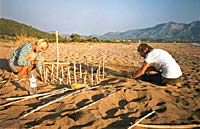 In Kyparissiakos Bay there are almost 700 Caretta caretta nests on a yearly basis, the majority of which (86%) is mainly found in the southest part of the bay, and more specifically, in a 10 km area, between Neda estuary and Kalo Horio village, which constitutes the heart of the habitat. This area has been included in the European network Natura 2000 under the code GR2550005 “Thines Kyparissias: Noehori – Kyparissia” mainly due to the reproduction of the sea turtles and the protected flora in the sand dunes zone. The sea area round the bay has also been included in the same network of protected areas under the code GR2330008 “Kyparissia bay sea area: Katakolo cape – Kyparissia” due to the existence of widespread Poseidonia meadows which constitute feeding and reproduction places for plenty and various organisms.
In Kyparissiakos Bay there are almost 700 Caretta caretta nests on a yearly basis, the majority of which (86%) is mainly found in the southest part of the bay, and more specifically, in a 10 km area, between Neda estuary and Kalo Horio village, which constitutes the heart of the habitat. This area has been included in the European network Natura 2000 under the code GR2550005 “Thines Kyparissias: Noehori – Kyparissia” mainly due to the reproduction of the sea turtles and the protected flora in the sand dunes zone. The sea area round the bay has also been included in the same network of protected areas under the code GR2330008 “Kyparissia bay sea area: Katakolo cape – Kyparissia” due to the existence of widespread Poseidonia meadows which constitute feeding and reproduction places for plenty and various organisms.
“Neda” Project in Giannitsochori of Ilia Prefecture
 Kyparissiakos Bay is the second biggest Mediterranean reproduction habitat of the Caretta caretta sea turtle. It is situated in West Peloponnesse, and extends from Katakolo cape, in the north, to Kounelos cape in the south. The magnificent sandy beach is 46 km long and it is only interrupted by Alfios River and two smaller ones – Neda and Arkadikos. The really magnificent scenery is characterized by the pine trees coastal forest all along the upper part of the beach, by the biggest and richest zone of sand dunes in Greece and by the intense ripple of the Ionian Sea that offers moments of peace and relaxation.
Kyparissiakos Bay is the second biggest Mediterranean reproduction habitat of the Caretta caretta sea turtle. It is situated in West Peloponnesse, and extends from Katakolo cape, in the north, to Kounelos cape in the south. The magnificent sandy beach is 46 km long and it is only interrupted by Alfios River and two smaller ones – Neda and Arkadikos. The really magnificent scenery is characterized by the pine trees coastal forest all along the upper part of the beach, by the biggest and richest zone of sand dunes in Greece and by the intense ripple of the Ionian Sea that offers moments of peace and relaxation.
In Kyparissiakos Bay there are almost 700 Caretta caretta nests on a yearly basis, the majority of which is mainly found in the southest part of the bay, and more specifically, in a 10 km area, between Neda estuary to the North and Kalo Nero village to the South, which constitutes the heart of the habitat. A significant number of nests, however, are found in the section of the bay which is located north of Neda estuary, until Giannitsochori of Ilia Prefecture, length of 4 km. The entire area has been included in the European network Natura 2000 under the code GR2550005 “Thines Kyparissias: Noehori – Kyparissia” mainly due to the reproduction of the sea turtles and the protected flora in the sand dunes zone. The sea area round the bay has also been included in the same network of protected areas under the code GR2330008 “Kyparissia bay sea area: Katakolo cape – Kyparissia” due to the existence of widespread Poseidonia meadows which constitute feeding and reproduction places for plenty and various organisms.
Since 1983 ARCHELON conducts a project of recording and protecting reproduction activity in the area between Neda estuaries and Kalo Horio village. In addition to this project and due to the celebration of 30 years since its foundation, ARCHELON opens a new project in Kyparissiakos Bay named “Neda”. The new project is placed in Giannitsoxori of Ilia Perfecture and will cover the area between Neda estuary to the South and Giannitsoxori to the North. Reproduction period starts late May and lasts till October. During this period, and more specifically from June 1 till September 30, with the participation of volunteers from around the world.
Lakonikos Bay
The Lakonikos Bay project is conducted at the beaches surrounding Gytheio, a beautiful town characterized by its picturesque port, neoclassical houses, narrow uphill alleys, stone paved streets and marble stairs. According to the Greek mythology here is the place where god Apollon fought with Hercules for the magic tripod of the Delphic oracle and where at the end they reconciled, giving the area its current name (Gytheio from the words gh and theos, which mean earth of the gods)
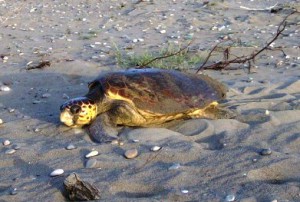 These unique, both in natural wealth and beauty, beaches of Lakonikos Bay have a total length of about 23 km and accommodate, in average, 200 Caretta caretta nests every year, whereas the sea area is the only spot in Greece where an other species of sea turtle, the green turtle (Chelonia mydas), is frequently encountered. A part of this area has been included in the european network Natura 2000 under the code GR2540003 “EVROTAS DELTA” as it constitutes not only a reproduction area for the sea turtles but serves as rest, reproduction and nourishment area for many bird species as well. Also, the sand dunes zone accommodates protected plant species such as the sea daffodil (Pancratium maritimum). The marine ecosystems of Lakonikos Bay include vast Posidonia meadows which serve as a reproduction area and a feeding ground for many organisms and fishes of commercial significance.
These unique, both in natural wealth and beauty, beaches of Lakonikos Bay have a total length of about 23 km and accommodate, in average, 200 Caretta caretta nests every year, whereas the sea area is the only spot in Greece where an other species of sea turtle, the green turtle (Chelonia mydas), is frequently encountered. A part of this area has been included in the european network Natura 2000 under the code GR2540003 “EVROTAS DELTA” as it constitutes not only a reproduction area for the sea turtles but serves as rest, reproduction and nourishment area for many bird species as well. Also, the sand dunes zone accommodates protected plant species such as the sea daffodil (Pancratium maritimum). The marine ecosystems of Lakonikos Bay include vast Posidonia meadows which serve as a reproduction area and a feeding ground for many organisms and fishes of commercial significance.
ARCHELON, noting that the area of Lakonikos Bay is an important nesting habitat of Caretta caretta sea turtles, first began a project about recording and protecting the nests in 1985, which carries on to the present day. Specifically reproductive activity is recorded at 4 beaches in the region (Mavrovouni, Vathy, Selinitsa, Valtaki), of total length of about 8.5 km, which are used as an “index area” for the rest of the region. The reproductive activity begins in early June and ends in the last days of September. During this period, with the participation of volunteers from around the world.
Koroni
Koroni, a beautiful coastal town of Messinia, is located at the southwestern end of the Messinian Gulf and is about 50 km away from Kalamata. It has about 2,000 inhabitants, most of who are engaged in agriculture, fishing and tourism, while it is estimated that during the summer months its population exceeds the 10,000, since because of its beauty, it is one of the major tourist destinations of Messinia. Koroni is famous for its Venetian castle that looms over the city, its special picturesqueness which is due to not only its unique geographical position, but also its architectural composition and the golden beaches that surround it.
 The significance of the Zaga – Memi beach in Koroni (2.7 km long) for the reproduction of the sea-turtle Caretta caretta had been identified since the late 80’s. It is a crowded beach that hosts an average of 40 nests every year. Since 1995 ARCHELON conducts each summer a project aiming the record and the protection of the nests. The reproductive activity begins in early June and ends in the middle of September. During this period, especially from 5 June through 15 September, with the participation of volunteers from around the world.
The significance of the Zaga – Memi beach in Koroni (2.7 km long) for the reproduction of the sea-turtle Caretta caretta had been identified since the late 80’s. It is a crowded beach that hosts an average of 40 nests every year. Since 1995 ARCHELON conducts each summer a project aiming the record and the protection of the nests. The reproductive activity begins in early June and ends in the middle of September. During this period, especially from 5 June through 15 September, with the participation of volunteers from around the world.
Volunteers can spend their free time having sea baths, attend one of each kind of cultural events that take place daily in Koroni, carefree browse the quaint streets of the city with their special houses and cobblestone streets and of course visit the neighboring beautiful cities in the region (Methoni Finikounda, Pylos, Gialova) where history and ancient monuments meet the rich natural beauty with many protected species of flora and fauna.
Information and activities
Since 1983 ARCHELON conducts a project of recording and protecting reproduction activity in the area between Neda estuaries and Kalo Horio village. Reproduction period starts late May and lasts till October. During this period, and more specifically from May 15 till September 30, with the participation of volunteers all over the world, ARCHELON runs the following activities:
- Morning observation, during which reproductive activity is recorded daily.
- Night observation and marking of adult sea turtles
- Nest protection from human activity and predation by mammals (foxes, dogs etc), which is done by enclosing and marking the nests and by shading them, where necessary.
- Excavation of nests after the exit of the hatchlings in order to estimate the number of them that left the nest.
- Public awareness by operating a seasonal information station in Kalo Nero village, by organizing information slide shows in tourist facilities and camping of the area, as well as by conducting beach patrols in order to raise the bathers’ awareness.
In the frame of the European Community LIFE – Nature program, conducted in the area by ARCHELON, two main actions should be noted:
- A special Environmental Study and Managerial Project for the coastal zone have been worked out in the aim of promoting – in collaboration with local society – a sustainable management for the efficient protection of the physical environment and the controlled development of the local economy
- A Scientific and Environmental Station has been founded in Agiannakis area which, in the range of environmental education program, organizes guided tours for schools and visitors.
Source: www.archelon.gr
διαβάστε περισσότεραSince 1983, the primary objective of ARCHELON, the Sea Turtle Protection Society of Greece has been to protect the sea turtles and their habitats in Greece through monitoring and research, developing and implementing management plans, habitat restoration, raising public awareness and rehabilitating sick and injured turtles.
ARCHELON is a Partner to the UNEP/Mediterranean Action Plan, a member of the European Union for the Conservation of the Coasts (EUCC). Members of ARCHELON participate in the IUCN/Marine Turtle Specialist Group and contribute to the formulation of the international strategy for the conservation of sea turtles.
ARCHELON works closely with state agencies, the local authorities, institutions, other NGOs, fishermen and local inhabitants in order to mitigate and reverse population reduction of sea turtles. Certain projects are co-funded by the European Commission. Priority is given to the elaboration and implementation of integrated management plans in the major loggerhead nesting areas in Greece (Zakynthos, Bays of Kyparissia and Lakonikos, and Crete). On Zakynthos ARCHELON conducts its projects under an agreement with the National Marine Park. Pilot sand dune restoration projects have been carried out behind nesting beaches.

- ARCHELON relies heavily on voluntary work. Every year over 500 volunteers from all over the world are invited to help with the work on the nesting beaches and the Rescue Centre.
- Every summer the major nesting areas in Greece (Zakynthos, Peloponnesus and Crete), around 75 kilometres are daily monitored.
- Every year over 2,500 nests are protected against human threats, predation and sea inundation.
- Every year around 300 turtles are tagged in order to monitor their movements in the sea. Recently satellite transmitters have been used.
- Over 50 injured sea turtles are treated every year at the Rescue Centre at Glyfada (Athens).
- Three permanent and 10 seasonal stations are operated by ARCHELON on Zakynthos, Peloponnesus and Crete. There are also working two First Aid Stations in Rethymno and in Amvrakiko Bay.
- About 200,000 tourists are directly contacted through ARCHELON’s diverse programmes every year
- Over 15,000 students participate every year in the educational programmes.
- ARCHELON participates in four Management Agencies of protected areas (National Marine Park of Zakynthos, Amvrakikos Bay, Mesolonghi Lagoon and Strofylia-Kotychi Lagoons) where sea turtle habitats are found.
- Volunteers Training Centre has been established for the environment, where seminars and presentations are taking place.
Website www.archelon.gr
Amvrakikos Gulf is semi-closed sea in the north-west part of Greece. It is watered by plenty of fresh waters and sediments, thanks to the rivers Arachthos, Louros, Vovos and Krikeliotis. It has a warm climate, shallow waters, many lagoons of a small depth and marshlands. All these favour the development of local flora and fauna, making the gulf one the most important wetlands of Europe. ARCHELON’s activity the past years has confirmed a significant presence of turtles in the area, especially near the estuaries of the rivers in the north-east part of the Gulf, although there has not been a record of a nesting site within the Gulf.
 Protection of the region
Protection of the region
The ecosystem of the Amvrakikos gulf is one of the 11 wetland regions of our country that have been characterized “of international importance” and are protected by the international treaty RAMSAR.
Due to the rarity of the morphology of the area, and also due to the presence of rare and endangered species, the wetlands have been included in the NATURA 2000 Network, the Barcelona convention (a convention on the protection of the Mediterranean Sea from pollution) and is protected by virtue of the Berne convention (regarding the conservation of European wildlife and natural habitats) and the Bonne convention.
The need to protect and preserve the area’s unique ecosystem, has led to the establishment of the National Park and the Amvrakikos Management Body, in 2008, that specifies usages, conditions and restrictions for the terrestrial, aquatic and sea regions of the Amvrakikos Gulf.
 The work of ARCHELON
The work of ARCHELON
ARCHELON has been monitoring the area for the past decade in order to research the turtle presence by spotting, tagging and satellite tracking the population.
Last year’s positive data has led us to establish a full season project in the area for the first time, in order to gather more information on the population’s activity. The field work consists of turtle monitoring and raising public awareness in the local community. Volunteers will have a closed contact with the turtles as they will be trained to spot and capture them in order to gather all the data needed.
Source: www.archelon.gr
διαβάστε περισσότεραIn “Alexander the Great” by Ulrich Wickens is stated that “in order to understand the Greeks we must get into the specificity of their nature” and as Jacob Burckhardt once said, “the myth is the virtual foundation of their entire being”.
It was usual for the Greeks, even in cold political cases, to refer to mythological incidents or to form the myths in accordance to the interests of their present as well to project their present situations to the mythical times in order to gain more power. Even in the life of Alexander the Great that was what played leading role.
(M.P. Nilsson, Cults, Myths, Oracles and Politics in Ancient Greece)
– Karl Kerenyi, Die Mythologie der Griechen, 1966
Green Greece
We are very happy that for the first time we are able to present the nature of Greece, its exceptional landscapes and unparalleled beauty to visitors from all over the world! With very important partners on our side, like the “Greek Society for the Conservation of Nature”, “ARCTUROS”, “MOm” and “ARCHELON”, we explore the accessible trails, lakes, rivers, forests, we meet the animals – but most of all, we spread our protective hand over the wildlife of Greece: the unique animals living in our country.
In this category and on GreeceNAtour page, visit the wild animals from home!
Active Tour
The natural landscape of Greece lends itself to activities of all kinds, all year round. The material collected (with the help of scientists and professionals) is being constantly enriched, aiming to provide you with the most complete information.
Activities are offered in the mountains, the sea … everywhere!
Pilgrimage Tour
Historical monasteries attached to the tradition of the Greeks since the 1st century BC – Byzantine buildings, churches, holy relics…
The steps of the Apostles of Jesus, who taught and founded the new faith in Greece.
We follow the trails of the great tradition of the Christian Orthodox religion.









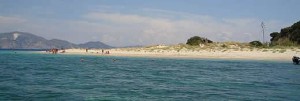 The uninhabited islet of Marathonissi is in the west of the Bay of Laganas. It has a small, 370m long beach made of pale thick sand on its north-west end. There are sand dunes on the back of the beach, which at some locations reach more than 50m inland. The steep hill behind the beach is covered by Mediterranean vegetation. The remains of an old monastery, belonging to the Church of Lithakia, is the only building on this islet. Tourists visit the beach during the day, on organised boat trips and by rented or private boats. Lights and noise from the residential areas of Laganas and Lithakia affect the beach during the night. Organized tours are allowed between 7:00am to 7:00pm from the 1st of May to the 31st of October. Visitors are only allowed to remain on the first 5m from the sea, as sea turtle nests are located on the back of the beach.
The uninhabited islet of Marathonissi is in the west of the Bay of Laganas. It has a small, 370m long beach made of pale thick sand on its north-west end. There are sand dunes on the back of the beach, which at some locations reach more than 50m inland. The steep hill behind the beach is covered by Mediterranean vegetation. The remains of an old monastery, belonging to the Church of Lithakia, is the only building on this islet. Tourists visit the beach during the day, on organised boat trips and by rented or private boats. Lights and noise from the residential areas of Laganas and Lithakia affect the beach during the night. Organized tours are allowed between 7:00am to 7:00pm from the 1st of May to the 31st of October. Visitors are only allowed to remain on the first 5m from the sea, as sea turtle nests are located on the back of the beach.
 East Laganas beach stretches eastwards from the last hotel of the developed part of Laganas (Louis Zante Beach Hotel), up to the Rock of Hipsolithos. East Laganas is characterised by fine sand mixed with small-sized pebbles and a landward extensive dune field. Visitors are allowed on the beach between 7:00am and 7:00pm from the 1st of May to the 31st of October.
East Laganas beach stretches eastwards from the last hotel of the developed part of Laganas (Louis Zante Beach Hotel), up to the Rock of Hipsolithos. East Laganas is characterised by fine sand mixed with small-sized pebbles and a landward extensive dune field. Visitors are allowed on the beach between 7:00am and 7:00pm from the 1st of May to the 31st of October.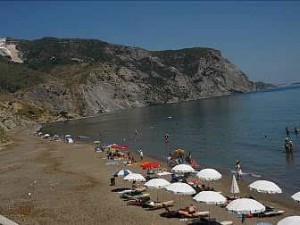 The beach of Kalamaki, with a length of 500m, is the eastward extension of the East Laganas beach, separated from it by the cliffs of Hipsolithos. Behind the beach there are low clay cliffs. A hotel has been constructed above the western part of the beach. The area has an easy access and it is visited by many people during the day. Visitors are allowed between 7:00am and 7:00pm from the 1st of May to the 31st of October. Visitors are only allowed to remain within a 5m distance from the sea, as sea turtle nests are located on the back of the beach.
The beach of Kalamaki, with a length of 500m, is the eastward extension of the East Laganas beach, separated from it by the cliffs of Hipsolithos. Behind the beach there are low clay cliffs. A hotel has been constructed above the western part of the beach. The area has an easy access and it is visited by many people during the day. Visitors are allowed between 7:00am and 7:00pm from the 1st of May to the 31st of October. Visitors are only allowed to remain within a 5m distance from the sea, as sea turtle nests are located on the back of the beach.
 Sekania beach (650m) is the one that stands out for its natural beauty and the highest nesting density for loggerheads in the Mediterranean. Sekania supports well over 50% of the total number of nests made in the whole Bay. Due to its importance, ARCHELON has been urging the Government to expropriate or buy the private land behind the beach, in order to declare it a site of absolute protection. Finally in 1994, WWF Greece, following recommendations by ARCHELON, purchased a large part of the land behind the nesting beach. This was achieved with partial funding from the European Union and the support of the Greek Ministry of Environment. According to existing legislation public access is prohibited.
Sekania beach (650m) is the one that stands out for its natural beauty and the highest nesting density for loggerheads in the Mediterranean. Sekania supports well over 50% of the total number of nests made in the whole Bay. Due to its importance, ARCHELON has been urging the Government to expropriate or buy the private land behind the beach, in order to declare it a site of absolute protection. Finally in 1994, WWF Greece, following recommendations by ARCHELON, purchased a large part of the land behind the nesting beach. This was achieved with partial funding from the European Union and the support of the Greek Ministry of Environment. According to existing legislation public access is prohibited. Daphni stands out as the beach with the most problems. All 15 illegal buildings constructed behind the beach of Daphni have not been removed. Following recommendations by the Council of Europe, the removal of illegal buildings at Daphni has been an obligation of the Greek Government since 1986, when only two prefabricated buildings existed. Unfortunately, nothing has been done so far towards this end on behalf of the state. Illegal embankments, street laying, planting of exotic species, and corrosion of the beach have destroyed the beach profile on many locations. Since 2006, the Management Agency of the Park came into agreement with the owners and imposed measures on the operation of the buildings and the beach management. Visitors are allowed from 7:00am to 7:00pm from the 1st of May to the 31st of October and must not exceed 100 at any one time. Visitors are only allowed within the first 5m from the sea, as sea turtle nests are located on the back of the beach.
Daphni stands out as the beach with the most problems. All 15 illegal buildings constructed behind the beach of Daphni have not been removed. Following recommendations by the Council of Europe, the removal of illegal buildings at Daphni has been an obligation of the Greek Government since 1986, when only two prefabricated buildings existed. Unfortunately, nothing has been done so far towards this end on behalf of the state. Illegal embankments, street laying, planting of exotic species, and corrosion of the beach have destroyed the beach profile on many locations. Since 2006, the Management Agency of the Park came into agreement with the owners and imposed measures on the operation of the buildings and the beach management. Visitors are allowed from 7:00am to 7:00pm from the 1st of May to the 31st of October and must not exceed 100 at any one time. Visitors are only allowed within the first 5m from the sea, as sea turtle nests are located on the back of the beach. Gerakas is a 15-30m wide beach, with fine and soft sand, and a length of 600m. The beach is backed by clay cliffs which shield off the lights of the two tavernas and the few houses that have been recently built further inland. A paved road comes very close to the beach and vehicles are parked there. There is only one access to the beach by a trail coming down through the cliffs. Due to its fair access, Gerakas attracts hundreds of visitors every day during the summer season. According to legislation only 60 umbrellas and 120 sunbeds are allowed at the western end of Gerakas, and the number of visitors on the beach at any one time should not exceed 350. Visitors are allowed from 7:00am to 7:00pm between the 1st of May and the 31st of October. They have to remain within the first 5m from the sea, as sea turtle nests are located on the back of the beach.
Gerakas is a 15-30m wide beach, with fine and soft sand, and a length of 600m. The beach is backed by clay cliffs which shield off the lights of the two tavernas and the few houses that have been recently built further inland. A paved road comes very close to the beach and vehicles are parked there. There is only one access to the beach by a trail coming down through the cliffs. Due to its fair access, Gerakas attracts hundreds of visitors every day during the summer season. According to legislation only 60 umbrellas and 120 sunbeds are allowed at the western end of Gerakas, and the number of visitors on the beach at any one time should not exceed 350. Visitors are allowed from 7:00am to 7:00pm between the 1st of May and the 31st of October. They have to remain within the first 5m from the sea, as sea turtle nests are located on the back of the beach.





